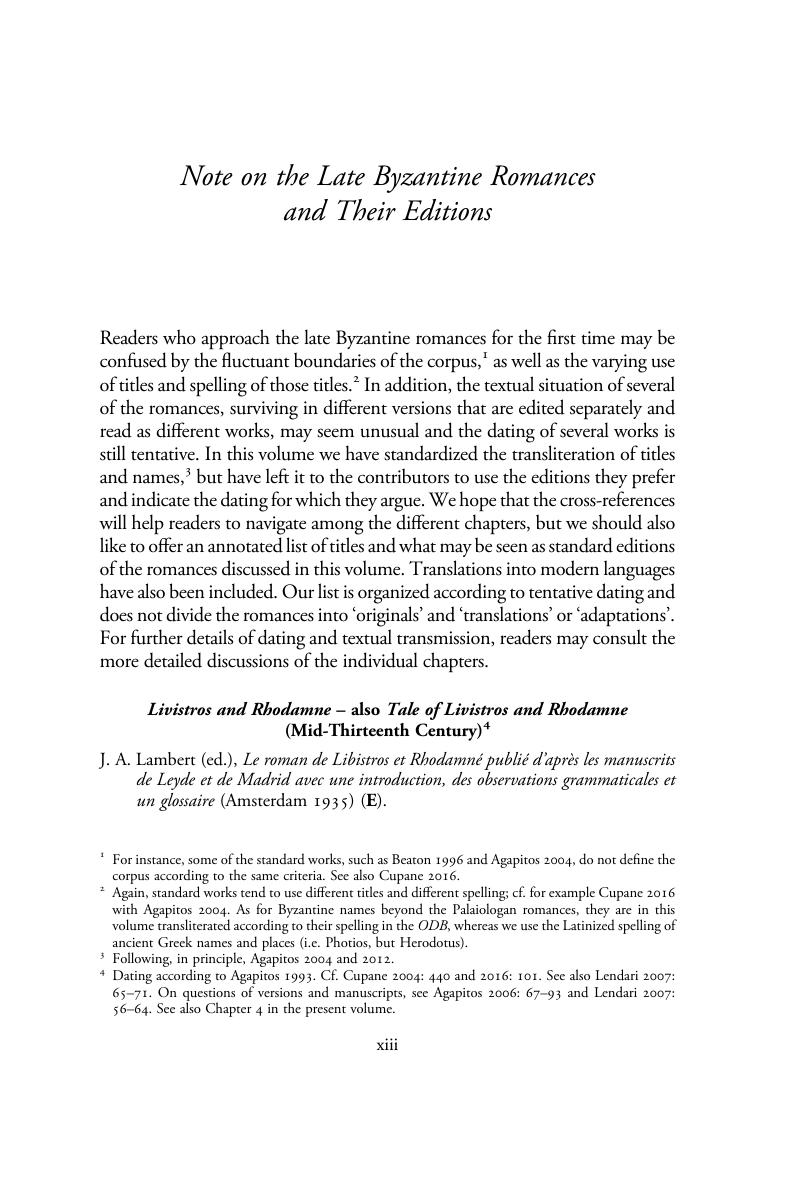Book contents
- Reading the Late Byzantine Romance
- Reading the Late Byzantine Romance
- Copyright page
- Contents
- Notes on Contributors
- Acknowledgements
- Note on the Late Byzantine Romances and Their Editions
- Chapter 1 An Introduction to the Palaiologan Romance
- Chapter 2 The Categories of ‘Originals’ and ‘Adaptations’ in Late Byzantine Romance
- Chapter 3 Intercultural Encounters in the Late Byzantine Vernacular Romance
- Chapter 4 Dreams and Female Initiation in Livistros and Rhodamne and Hypnerotomachia Poliphili
- Chapter 5 The Acculturation of the French Romance Pierre de Provence et la belle Maguelonne in the Byzantine Imperios and Margarona
- Chapter 6 Chronotopes between East and West in Apollonios of Tyre
- Chapter 7 Linguistic Contacts in the Late Byzantine Romances
- Chapter 8 From Herakles to Erkoulios, or the Place of the War of Troy in the Late Byzantine Romance Movement
- Chapter 9 Troy in Byzantine Romances
- Chapter 10 Herodotean Material in a Late Version of the Alexander Romance
- Chapter 11 The Palaiologan Hagiographies
- Chapter 12 Homosocial Desire in the War of Troy
- Chapter 13 Literary Landscapes in the Palaiologan Romances
- Chapter 14 The Affective Community of Romance
- Chapter 15 The Bookseller’s Parrot
- Index
- References
Note on the Late Byzantine Romances and Their Editions
Published online by Cambridge University Press: 17 December 2018
- Reading the Late Byzantine Romance
- Reading the Late Byzantine Romance
- Copyright page
- Contents
- Notes on Contributors
- Acknowledgements
- Note on the Late Byzantine Romances and Their Editions
- Chapter 1 An Introduction to the Palaiologan Romance
- Chapter 2 The Categories of ‘Originals’ and ‘Adaptations’ in Late Byzantine Romance
- Chapter 3 Intercultural Encounters in the Late Byzantine Vernacular Romance
- Chapter 4 Dreams and Female Initiation in Livistros and Rhodamne and Hypnerotomachia Poliphili
- Chapter 5 The Acculturation of the French Romance Pierre de Provence et la belle Maguelonne in the Byzantine Imperios and Margarona
- Chapter 6 Chronotopes between East and West in Apollonios of Tyre
- Chapter 7 Linguistic Contacts in the Late Byzantine Romances
- Chapter 8 From Herakles to Erkoulios, or the Place of the War of Troy in the Late Byzantine Romance Movement
- Chapter 9 Troy in Byzantine Romances
- Chapter 10 Herodotean Material in a Late Version of the Alexander Romance
- Chapter 11 The Palaiologan Hagiographies
- Chapter 12 Homosocial Desire in the War of Troy
- Chapter 13 Literary Landscapes in the Palaiologan Romances
- Chapter 14 The Affective Community of Romance
- Chapter 15 The Bookseller’s Parrot
- Index
- References
Summary

- Type
- Chapter
- Information
- Reading the Late Byzantine RomanceA Handbook, pp. xiii - xxPublisher: Cambridge University PressPrint publication year: 2018
References
Livistros and Rhodamne – also Tale of Livistros and Rhodamne (Mid-Thirteenth Century)4
War of Troy (Second Half of Thirteenth Century)5
Velthandros and Chysantza (Late Thirteenth Century)6
Kallimachos and Chrysorrhoe (First Half of Fourteenth Century)7
Tale of Achilles – also Achilleid (Mid-Fourteenth Century)8
Apollonios of Tyre – also The Story of Long-Suffering Apollonios of Tyre (Mid-Fourteenth Century)10
Florios and Platziaflore (Second Half of Fourteenth Century)11
Tale of Troy – also Byzantine Iliad (Late Fourteenth–Early Fifteenth Centuries)13
Alexander and Semiramis (First Half of Fifteenth Century)14
Old Knight (First Half of Fifteenth Century)
Imperios and Margarona (Mid-Fifteenth Century)15
Teseida – also The Marriage of Theseus and Aemilia (Late Fifteenth Century)17
In addition to this more or less stable core of twelve Palaiologan romances, some other texts that are more loosely connected to the corpus are discussed in the present volume and therefore deserve to be mentioned and listed here. One is the Digenis Akritis (ed. Jeffreys 1998), previously dated to the twelfth century and by Beaton referred to as a ‘proto-romance’, but here treated as narratologically and thematically related to the Palaiologan romances, at least in its version G (dated to the late thirteenth or even fourteenth century). Another is the Alexander Romance, the immensely popular fictional biography that survives in numerous versions and translations from late antiquity onwards.18 Usually treated very differently in scholarship, the different versions among the varied manuscripts may be said to straddle the learned and vernacular traditions, representing an impressively long span of storytelling. Frequently mentioned in several chapters in the present volume and often referenced in the discussion of the Palaiologan romances more generally are also the four Komnenian novels, which therefore deserve to be listed below. Finally, two allegorical poems are often mentioned in relation to the romances: the anonymous Consolatory Fable about Bad and Good Fortune, probably from the first half of the fourteenth century and written in the vernacular register, and the Verses on chastity by Meliteniotes, composed in learned Greek in the middle of the same century. Our first list may then be complemented with the following.
Komnenian Novels (Twelfth Century)19
Digenis Akritis (Twelfth Century/Version G of Thirteenth–Fourteenth Centuries)20
Consolatory Fable about Bad and Good Fortune (First Half of Fourteenth Century)
Meliteniotes, Verses on Chastity (Mid-Fourteenth Century)21
Many other texts from various stages of the Greek language, along with western and eastern romances, are mentioned in the course of the following chapters,22 but we hope that this brief introduction to the most frequently discussed late Byzantine romances and related texts will help the reader to navigate both this volume and the secondary literature to which the respective chapters refer.



